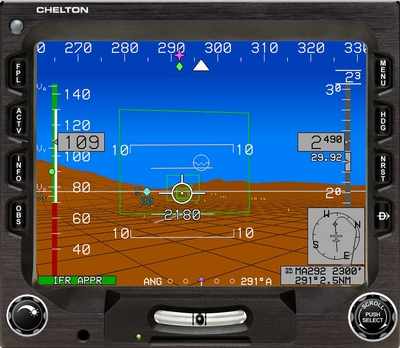 The FAA has granted Chelton Flight Systems a TSO
for its synthetic vision Electronic Flight Information System
(EFIS). This marks the first time FAA has approved the long-touted
Highway-In-The-Sky (HITS) technology which significantly reduces
pilot workload while substantially increasing situational awareness
in VFR and especially IMC flight environments. Though a number of
companies have been working on General Aviation EFIS, Chelton's
Flight Logic System is the only one that incorporates synthetic
vision, a flight path marker, and HITS providing a 3-D series of
boxes along the flight path from takeoff to touchdown. Selected for
the FAA's Capstone program, the certification of this technology
was a groundbreaking partnership between industry and a progressive
FAA.
The FAA has granted Chelton Flight Systems a TSO
for its synthetic vision Electronic Flight Information System
(EFIS). This marks the first time FAA has approved the long-touted
Highway-In-The-Sky (HITS) technology which significantly reduces
pilot workload while substantially increasing situational awareness
in VFR and especially IMC flight environments. Though a number of
companies have been working on General Aviation EFIS, Chelton's
Flight Logic System is the only one that incorporates synthetic
vision, a flight path marker, and HITS providing a 3-D series of
boxes along the flight path from takeoff to touchdown. Selected for
the FAA's Capstone program, the certification of this technology
was a groundbreaking partnership between industry and a progressive
FAA.

"People have been telling us for years that the FAA would never
approve this technology," said company president Gordon Pratt. "In
reality, we could hae never accomplished this without them. Our
experience with both our Certification Office and the Directorate
has been extremely positive." The primary flight display in
Chelton's EFIS combines pitot-static information from an airdata
computer, attitude and heading data from a solid state three-axis
gyro, and position input from a GPS WAAS receiver (included with
the system). All of these components have received TSO
approval.
This equipment generates a state of the art display that test
pilots have called "virtual VFR" because what is shown on the
screen is the same terrain the pilot sees (or cannot see) out the
window. Three-dimensional terrain modeling, airspeed, groundspeed,
altitude MSL, altitude AGL, vertical speed, enhanced low-speed
awareness, heading, decision height, actual winds aloft, crosswind
component, OAT, and timers are constantly updated in the display
while airborne. Other essential information appears as "pop ups"
when any unusual flight situations begin to develop. If conditions
are normal, the screen declutters, providing only the essential
information for keeping track of aircraft performance and
navigation.

In addition to the synthetic vision EFIS PFD, which depicts a
3-D flight path, there is a Navigation Display. This consists of a
moving map that utilizes Jeppesen NavData and has the capability to
include weather and traffic data. The map displays flight path and
terrain that is near or above the pilot¹s current altitude and
satisfies the FAA TAWS mandate for all turbine-powered aircraft.
Two unique features of the moving map display are a horizontal
projected path showing a wind-corrected track of the aircraft up to
one minute in the future, and a patented deat-stick glide area
depiction that is corrected for turns, wind and terrain. A
conventional HSI/RMI presentation is also included.
In addition to being TSO'd, the FlightLogic EFIS is
STC'd for over 600 general aviation aircraft and
is shipping now. Civilian pilots have never had access to synthetic
vision or HITS with real time terrain modeling before. The
simplicity of Chelton's FlightLogic System and its effectiveness in
keeping pilots on course and aware of where that course is taking
them is sure to have a significant impact on general aviation
safety over the next decade. Chelton is a U.S. subsidiary of Cobham
plc, a publicly traded $2 billion UK company.
 ANN's Daily Aero-Term (05.01.24): Say Altitude
ANN's Daily Aero-Term (05.01.24): Say Altitude ANN's Daily Aero-Linx (05.01.24)
ANN's Daily Aero-Linx (05.01.24) Classic Aero-TV: Korean War Hero Twice Reborn
Classic Aero-TV: Korean War Hero Twice Reborn Airborne 04.29.24: EAA B-25 Rides, Textron 2024, G700 Deliveries
Airborne 04.29.24: EAA B-25 Rides, Textron 2024, G700 Deliveries Airborne Affordable Flyers 05.02.24: Bobby Bailey, SPRG Report Cards, Skydive!
Airborne Affordable Flyers 05.02.24: Bobby Bailey, SPRG Report Cards, Skydive!





